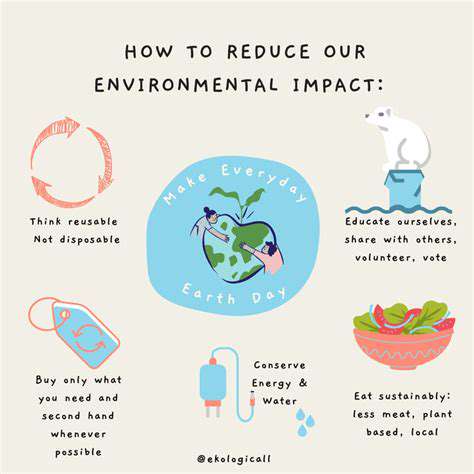Maintaining a Safe Distance and Avoiding Interactions
Respecting Wildlife's Space
A fundamental principle of wildlife photography ethics is respecting the animals' space. This means maintaining a safe distance that allows them to behave naturally, without feeling pressured or threatened by your presence. Approaching too closely can disrupt their feeding, breeding, or resting patterns, and even cause stress that can have long-term negative impacts on their well-being. Understanding the animals' natural behaviors and habitats is crucial to ensure you don't inadvertently cause harm or disturbance.
Consider the animal's size and temperament. A large, powerful creature, like a bear or elephant, requires a considerably larger buffer zone than a smaller, more timid animal, like a bird or rabbit. Always prioritize the animal's comfort and safety above your desire for a perfect shot.
Minimizing Disturbance
Noise pollution, whether from loud conversations, vehicles, or even the clicking of cameras, can significantly disrupt wildlife. Try to minimize noise as much as possible. This includes using quieter equipment, like a camera with a quieter shutter, and keeping your voice down when in the vicinity of animals. Even seemingly minor disturbances can have a cumulative effect, leading to long-term stress and potentially impacting their survival.
Avoiding Interactions
Interacting with wildlife, even seemingly harmless interactions like offering food, is strictly discouraged. Wild animals are not domesticated and have no understanding of human intentions. Feeding wild animals can create dependency issues and alter their natural behaviors. This can make them habituated to human presence, potentially leading to dangerous situations for both the animals and humans.
Understanding Local Regulations
Wildlife photography practices are often governed by local regulations and conservation guidelines. Familiarize yourself with these regulations before entering a wildlife area. These regulations often dictate permissible distances, permitted equipment, and restrictions on interacting with animals. Following local guidelines is essential to ensure you're not violating any laws or contributing to negative impacts on the ecosystem.
Choosing Appropriate Equipment and Techniques
Employing appropriate equipment and techniques is key to minimizing disturbance. Using telephoto lenses to maintain a safe distance, choosing quiet equipment, and utilizing camouflage clothing can significantly reduce your impact on the animals. Be mindful of your camera's sound and try to minimize the frequency or intensity of your camera's use, particularly during critical times like breeding season or feeding.
Prioritizing Conservation Efforts
Your actions as a wildlife photographer can either support or undermine conservation efforts. By respecting animals' space, minimizing disturbance, and avoiding interactions, you contribute to the preservation of their natural habitats and behaviors. Supporting organizations dedicated to wildlife conservation is another important aspect of demonstrating ethical practice. Education and awareness are crucial in ensuring the long-term survival of these magnificent creatures.
Minimizing Environmental Impact and Avoiding Disturbance

Minimizing Waste Generation
Reducing waste generation is crucial for minimizing environmental impact. This involves adopting a proactive approach to consumption, focusing on minimizing the amount of waste produced at each stage of the product lifecycle. Efficient resource utilization and waste reduction strategies are key to this process. This includes implementing strategies for reuse, repair, and recycling to divert waste from landfills.
Implementing effective waste management systems, from source reduction to proper disposal, is vital. Proper waste segregation and recycling programs can significantly reduce the environmental burden, preventing pollution and conserving valuable resources.
Sustainable Sourcing and Procurement
Sustainable sourcing is essential for minimizing environmental impact. This involves procuring materials and products from suppliers who prioritize environmentally responsible practices. Choosing suppliers who adhere to strict environmental standards is critical to ensuring that the entire supply chain is working towards sustainability goals. This includes evaluating the environmental footprint of materials throughout the supply chain, and choosing options that minimize pollution and resource depletion.
Energy Efficiency and Conservation
Energy efficiency and conservation are vital components of environmental responsibility. By minimizing energy consumption, we lessen our reliance on fossil fuels and reduce greenhouse gas emissions. Investing in energy-efficient technologies and practices is paramount to achieving significant reductions in energy use across various sectors. This can lead to substantial cost savings while contributing to a greener planet.
Implementing energy-efficient lighting, equipment, and building designs can drastically reduce energy consumption. Adopting sustainable transportation options like cycling and public transport also plays a role in reducing carbon emissions and conserving energy.
Responsible Consumption and Production
Responsible consumption and production patterns are crucial for minimizing environmental impact. Consumers need to be mindful of their purchasing decisions, opting for products with minimal environmental impact, prioritizing durability and repairability over disposability. Sustainable consumption patterns are essential for reducing waste and promoting a circular economy.
Protecting and Restoring Ecosystems
Protecting and restoring ecosystems is paramount in minimizing environmental impact. Conserving biodiversity, restoring degraded habitats, and promoting ecological balance are essential for maintaining healthy ecosystems. This includes supporting initiatives that protect natural resources and promote sustainable land management practices. Conservation efforts are crucial for safeguarding vital ecosystems and preventing biodiversity loss, which in turn supports a healthy planet.
Promoting Environmental Education and Awareness
Promoting environmental education and awareness is essential for fostering a culture of sustainability. Raising public awareness about environmental issues and providing opportunities for education are vital steps in encouraging individuals and communities to adopt environmentally responsible behaviors. Education empowers individuals with the knowledge and understanding needed to make informed choices that benefit the environment. This includes fostering a greater understanding of environmental issues and encouraging active participation in environmental protection initiatives.
Understanding the Importance of Conservation and Advocacy
Ethical Considerations in Wildlife Photography
Wildlife photography, a captivating blend of art and science, carries a profound responsibility. Ethical considerations are paramount, ensuring the welfare of the animals and the preservation of their habitats. Photographers must prioritize the well-being of the subjects, avoiding actions that could cause stress, injury, or disturbance. This includes maintaining a safe distance and refraining from using flash photography in sensitive situations or at inappropriate times.
Respect for the animal's natural behavior and space is crucial. Disturbing their routines or seeking unusual or unnatural poses can have negative consequences for their health and overall well-being. A key aspect of ethical wildlife photography is understanding the animal's behavior and acting accordingly. Learning about the species being photographed is essential for respecting their needs and limitations.
Protecting Habitats Through Photography
Beyond individual animal interactions, wildlife photography can play a vital role in raising awareness about habitat conservation. Images can powerfully illustrate the beauty and fragility of ecosystems, prompting viewers to understand the threats they face. Photographs of pristine environments, juxtaposed with images of degraded landscapes, can effectively communicate the importance of conservation efforts and spark empathy and action.
Conservation organizations and advocacy groups often leverage compelling wildlife photography to generate public support for their initiatives. Stunning images can effectively convey the urgency of protecting endangered species and their habitats, motivating individuals and communities to become involved in conservation efforts. Sharing these images on social media and in other public forums is an effective way of spreading the message.
The Role of Advocacy in Conservation
Wildlife photography, when coupled with advocacy, can significantly influence policy and practice. Photographs can serve as powerful evidence for the detrimental impacts of human activities on wildlife and their environments. Using visual storytelling to convey the plight of endangered species can galvanize support for stricter regulations, conservation policies, and sustainable practices in tourism and development.
Advocating for conservation isn't just about taking pictures; it's about using the platform that photography provides to connect with others and inspire change. Photographers can actively participate in campaigns, contribute to research, and engage with policymakers, using their images to amplify the voices of conservationists and environmentalists. This powerful combination of visual representation and advocacy can drive tangible results in the fight for wildlife protection.
Sustainable Practices in Wildlife Photography
Sustainable practices are essential for minimizing the environmental impact of wildlife photography. Photographers should prioritize responsible travel, using eco-friendly transportation options and minimizing waste during their expeditions. Choosing accommodations that prioritize sustainability and supporting local communities are important considerations to minimize the ecological footprint.
Photographers have a responsibility to support conservation efforts by contributing financially or volunteering their time. Supporting local guides and communities involved in conservation initiatives is a way to ensure that wildlife photography benefits the environment and local economies. This includes practicing ethical sourcing for equipment and materials to minimize the impact on both wildlife and the environment.
Responsible Equipment Use and Light Sensitivity

Safe Handling Procedures
Proper handling of equipment is paramount to preventing accidents and ensuring the longevity of the equipment itself. Always consult the manufacturer's instructions before operating any equipment. These instructions will detail the specific safety precautions and operating procedures necessary for safe use. Following these guidelines diligently can significantly reduce the risk of injury and damage.
Regular maintenance is also crucial in maintaining the safety and efficiency of equipment. Scheduled inspections and repairs can identify potential problems early on, preventing more significant issues down the line. Failure to maintain equipment can lead to malfunctions and pose serious safety risks.
Light Source Selection
Selecting the appropriate light source is critical for both safety and efficiency. Different tasks require different light intensities and color temperatures. For example, tasks requiring high precision, such as surgery or intricate machinery repair, necessitate high-intensity, focused light sources. Choosing the incorrect light source can lead to reduced visibility and increase the risk of errors.
Consider factors such as the working environment and the nature of the task when selecting the light source. Harsh environments may require more durable and resilient light sources, while delicate tasks might necessitate a softer, more focused light. Proper light selection can significantly improve worker comfort and productivity.
Illumination Techniques
Effective illumination techniques maximize the benefit of light sources. Strategic placement of lights can minimize shadows and enhance visibility, promoting safe and efficient work practices. Properly positioned lights can significantly improve the overall quality of the work environment.
Consider using diffusers or reflectors to soften the light and reduce glare. These techniques can prevent eye strain and improve the overall visual comfort of workers. Reducing glare can significantly improve safety and productivity.
Electrical Safety Precautions
Electrical equipment requires particular attention to safety. Always ensure that equipment is properly grounded and that electrical cords are in good condition. Damaged or frayed cords pose a significant fire hazard and can lead to electric shocks. Inspect cords regularly for any signs of damage.
Never overload electrical circuits. Doing so can lead to overheating and potential fires. Use appropriate extension cords and power strips, and ensure they have the necessary amperage rating for the equipment you are using. Overloading circuits can lead to electrical malfunctions and fires.
Ergonomics and Posture
Proper ergonomics is vital for preventing musculoskeletal injuries. Ensure that equipment is positioned and used in a way that minimizes strain on the user's body. This includes adjusting the height of work surfaces and ensuring proper posture during use. Maintaining correct posture while using equipment can prevent chronic pain and injuries associated with repetitive motions.
Consider using supportive equipment such as adjustable chairs or footrests, particularly when prolonged use is required. Proper ergonomic practices can substantially reduce the risk of long-term health issues. Providing appropriate ergonomic support can significantly reduce the risk of workplace injuries.
Environmental Considerations
The environment plays a significant role in the safe and effective use of equipment. Consider factors such as temperature, humidity, and potential hazards in the surrounding area. These factors can impact the equipment's performance and safety, and appropriate protective measures need to be implemented.
Maintenance and Inspection Schedules
Regular maintenance and inspections are crucial for preventing equipment failures and ensuring safety. Develop a schedule for routine inspections and maintenance to identify potential problems early on. Consistent maintenance can prevent equipment breakdowns and ensure its optimal performance.
Document all maintenance activities, including the date, type of maintenance, and any issues identified. This documentation will be valuable for tracking the equipment's history and ensuring compliance with safety regulations. Proper documentation is critical for regulatory compliance and future troubleshooting.










